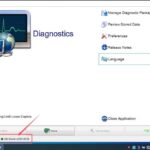Connecting an OBD2 scan tool to your car’s computer should be a simple process. However, sometimes you might encounter an “Obd2 Communication Error” or a “No Communication” message. This frustrating issue can prevent you from diagnosing car problems and reading error codes. This article explores common causes of OBD2 communication errors and provides troubleshooting steps to help you get connected.
Common Causes of OBD2 Communication Errors
Several factors can contribute to communication problems between your OBD2 scanner and your vehicle. Here are some of the most frequent culprits:
Ignition Key Position
Many OBD2 scanners require the ignition key to be in the “Run” position (sometimes labeled “KOEO” – Key On Engine Off) or for the engine to be running. Ensure your key is in the correct position and wait for all dashboard lights and chimes to settle before attempting to connect the scanner. Some vehicles require a few extra seconds for their systems to fully boot up.
Connector Voltage Issues
The OBD2 connector relies on power from the car’s battery. Pin 16 should have 12 volts, while pins 4 and 5 provide ground. Low or no voltage can prevent communication. Check these pins with a voltmeter: a reading significantly below 11 volts on pin 16 (relative to ground) can indicate a problem. A blown fuse related to the accessory power circuit is often the cause of no voltage. Consult your owner’s manual to locate and check the relevant fuse. Low voltage may indicate a weak battery or charging system issue.
Scan Tool Compatibility
While most modern cars use standardized OBD2 protocols, some older vehicles or specific models may utilize proprietary communication systems. If your scan tool isn’t compatible with the vehicle’s protocol (e.g., ALDL, MOBD), it won’t be able to connect. A professional-grade multi-system scanner with broader compatibility might be necessary in these cases.
ECM Issues
Occasionally, the Engine Control Module (ECM) can get “stuck” in a state where it functions normally but doesn’t communicate externally. Try rebooting the ECM by disconnecting both battery cables for a few minutes and then touching the positive and negative cables together (away from the battery) to discharge any residual power. Reconnect the battery and try the scanner again. Always consult your owner’s manual before disconnecting the battery, as some vehicles require specific procedures.
Data Mismatch
Scan tools often store data from previous vehicles. If the stored data doesn’t match your current vehicle, communication problems can arise. Some scanners automatically query the vehicle for the correct parameters (PIDs). If yours doesn’t, manually initiating a PID scan might resolve the issue. This process ensures the scanner is using the right data set for your car.
Conclusion
Troubleshooting OBD2 communication errors often involves a systematic check of the basics: ignition key position, connector voltage, compatibility, and ECM status. By following these steps, you can often pinpoint the source of the problem and get your scan tool communicating with your car. Remember, a reliable OBD2 scanner and a good understanding of your vehicle’s systems are essential for accurate diagnostics and troubleshooting. If you continue to experience issues, consulting a qualified automotive technician is recommended.

